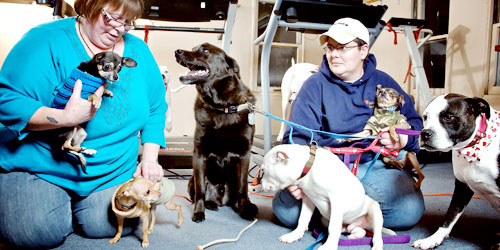by Jessica Carreras

Heather Mehi is recalling the infamous July 2009 Chihuahua rescue, and the memories are almost too much to handle.
The smell permeating from the Dearborn home with boarded-up windows and a strangely immaculate exterior. The mountains of garbage inside, stacked floor to ceiling. The rotted floors, collapsing from the compiled excrement of the dogs living there. News crews and journalists circling the two-story home, with Dearborn Animal Shelter manager Mehi and her team dashing in and out, dressed in gas masks and HAZMAT suits, saving as many of the 100-plus dogs trapped inside as they could.
It was like being in a horror movie.
And even now, with almost every Chihuahua adopted out and homeowner Kenneth Lang Jr. sentenced to five years probation and one count of animal cruelty, thinking about the four-day span in the home brings Mehi to tears.
The hoarding case, one of four the Dearborn Animal Shelter handled last year, was by far the worst they had ever dealt with.
"I've been with the shelter 14 years and we've had some cat hoarding cases, but nothing like that," Mehi says. "I'd never been in the houses before, but I had seen pictures and they were gross – but not like this house."
Mehi knows a thing or two about houses filled with dogs – but happier ones than the residence she encountered last summer. Her own Van Buren Township home, recently purchased with her partner, Anna Ebi, is shared with 10 dogs, as well as several cats, a bird and five turtles. It's a busy household, filled with constant feedings, reprimands and the sounds of barking hounds.
Mehi spoke about her experiences with the Chihuahua rescue and her own lifelong love of animals while sitting in her loft, going about her daily routine with her pets. The scene is almost comical: Three Chihuahuas (one adopted from the July hoarding case) run around in diaper-like contraptions called "pee pads." The cats are hardly seen, coming out now and again to eat or rub against someone's leg. And while some dogs wait outside, four pit bulls go for a walk. On treadmills.
The couple laughs at the ridiculousness of the situation, but admits that there really is no other way to ensure that their dogs get the exercise they need. "By the time I got to dog number 10, I'd have to start back over because it'd take so long to walk them all," Mehi jokes about trying outdoor walks.
And how exactly does a couple end up with so many pets?
Mehi explains that while she started out with three dogs in her Melvindale home, the number quickly grew as she and Ebi began fostering pit bulls – and never giving them up.
It's a habit she developed early on, bringing stray animals home that Mehi says she was rarely allowed to keep. But she just had to have a dog. "When I was little, I wanted a dog so bad that every day, my mom would come home and go, 'Where's Heather?' and she'd go into the kitchen and I'd be sitting there tied to the table, acting like a dog. I wouldn't eat or nothing because I wanted a dog," she recalls with a laugh. "And I got one for my fifth birthday, and I've had one ever since."
Or at least one.
But though Mehi and Ebi's home is crowded, it's clean and orderly. Each animal has its place to sleep, and the dogs often run around the 2.5-acre yard.
Mehi explains that the number of pets does not decide hoarding cases, but how the animals and home are kept.
The other three cases last year included homes with 45, 25 and 13 cats – the last containing fewer animals than the two have in their own home. But the animals are often underfed and not taken care of; their coats shabby and their cat boxes, nonexistent.
In many cases, according to the Mayo Clinic, compulsive hoarding goes beyond – or may not even include – animal ownership, but the obsessive collection of all kinds of items. Hoarders, whose syndrome is closely related to Obsessive Compulsive Disorder, often have no idea they have a problem, such was the case with Dearborn's Lang, who knew only that he had "too many dogs."
To rescuers like Mehi, the man's home was horrific. Dogs were not fed, and many survived only off of their own feces. Others died or were euthanized by Lang, and over 150 carcasses were found in the house – many kept in freezers. Several dogs were kept in Tupperware-like containers. Most dogs, however, roamed the house in tunnels burrowed through the trash piles.
It was those tunnels that Mehi and her team had to crawl through to rescue the Chihuahuas, astonished as dog after dog was found. According to Mehi, the animal shelter had no idea how many dogs were in the house, and were told by the animal control officers who first discovered the situation that there were 15, maybe 30, animals.
"We saw it and it was just overwhelming," Mehi says. "The thought that these dogs were in there, living like that."
The effect of the experience on Mehi was profound, causing sleeplessness, nightmares and claustrophobia. "It did affect her at home, believe me," Ebi says. "We had a tiny house, and if you can imagine, everything we had packed into our little house and all of our dogs, she was having a hard time being home because it just was too much for her."
Luckily, Mehi had a slew of volunteer and hired help at the shelter, caring for the dogs and helping them to be placed into new homes. The experience, she says, bonded them in a way that only crisis can. "It just brought everybody closer together," she explains. "We became more of a family than just my employees. It gave me a whole lot of respect for them and what they're doing."
The outpouring of families willing to adopt and foster the dogs was amazing, Mehi adds, and it helped some of the other animals to get adopted, too.
"It was the biggest thing that ever happened to our shelter."
And to Mehi, who took a "souvenir" home with her: Pudge, a dark brown Chihuahua.
Pudge, says Mehi, was found in a closet along with another dog. Malnourished and scared, he jumped directly into her arms when she opened the door, licking the only patch of skin showing from where her mask met her HAZMAT suit.
"That was the first time I actually thought of what I was seeing, what I was doing and what this guy had done to the dogs," Mehi shares with tears in her eyes. "I had to go outside, but I didn't put (Pudge) down because I just didn't want to let him go.
"I needed him for me to be OK with this."
It's been six months since the rescue, and both Mehi and Pudge are OK, sharing an unspoken bond from what happened in that house. Twelve other Chihuahuas remain in foster care, but the rest of the over 100 rescued are in new homes.
The Dearborn Animal Shelter, which almost doubled its capacity due to the hoarding cases, is now down to less than 100 cats – not perfect, but manageable. The point is that the worst is over, and though horrible, Mehi's experience has not deterred her from working with animals for the rest of her life.
"There's so much of a reward, working with the animals," she says, still holding Pudge close to her heart. "There's a lot of heartache, too, but I like making a difference for them and being the one that helps them get better and find their way, because they can't do it themselves."
To learn more about the Dearborn Animal Shelter, or to volunteer, visit http://www.dearborn-animals.com.











